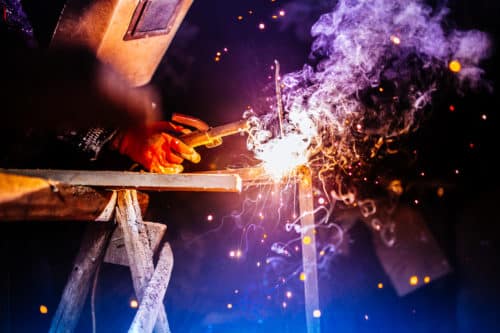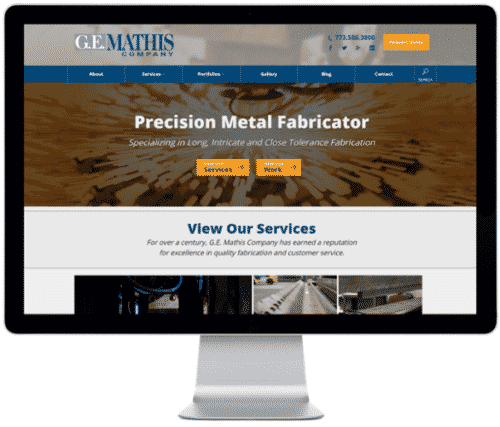Understanding Different Types of Welding
An extremely versatile fabrication process, welding is used in nearly every industry, from agriculture and mining to construction and aerospace. Over the years, specialized welding techniques have been developed to better suit the needs of specific industry challenges, whether they involve fusing dissimilar metals or custom fabricating parts for critical-use applications.
To determine which type of welding is best suited for a specific project, welders must consider the physical properties of the workpiece and filler material, desired product specifications, necessary equipment and power supplies, and the customer’s timeframe.
Let’s look at some of today’s most widely used welding methods and how they differ:
Types of Welding
Submerged Arc Welding
Requiring a continuous electrode feed to create an arc between a welding rod and the workpiece, this type of welding adds a thick granular flux to form a shield. The result is a flux blanket, under which the arc is submerged to protect the weld zone from atmospheric contamination. This process can be automated, mechanized, or semi-automated through the use of hand-held guns.
Shielded Metal Arc Welding (SMAW)
Commonly referred to as “stick” welding, shielded metal arc welding (SMAW) is an inexpensive, manual process requiring a welding rod coated in flux, which carries a high-power electric current. During welding, the electrode’s flux coating breaks down, creating a layer of slag as well as a gas shield to protect the weld until it cools. Final products may require finishing services, however, as molten splatter is a common occurrence.
Gas Metal Arc Welding (GMAW)
Gas metal arc welding, also called MIG (metal inert gas) welding, is distinct in its use of an adjustable, continuous solid wire electrode feed. Versatile and easily automated, GMAW only requires that the welder guides the welding gun in the proper position and orientation along the fusion point. The electric arc formed between the electrode and the workpiece heats and melts the metals to join them.
Flux Core Arc Welding (FCAW)
Similar to MIG welding, flux core arc welding uses a tubular wire filled with flux in place of a solid wire. Dual-shielded FCAW uses the flux with an external shielding gas for protection, while self-shielded FCAW relies only on flux to protect the molten weld puddle, making this an ideal option for outdoor applications. As an automated process, FCAW is also popular for projects requiring quick turnaround times.
Gas Tungsten Arc Welding (GTAW)
Gas tungsten arc welding, more commonly referred to as TIG (tungsten inert gas) welding, uses a non-consumable tungsten welding rod (or electrode) to apply intense heat to the base metal. This produces an autogenous weld by melting two pieces of metal directly together without a filler. TIG welds are also protected by an external shielding gas — usually argon. This method produces strong, high-quality welds, though the process can be painstaking, requiring extreme focus and precision to weld the small space between the arc and the workpiece.
Specialty Welding at G.E. Mathis Company
At G.E. Mathis Company, our experienced, skilled team of sheet metal welders is certified to AWS D1.1, D1.6, D9.1, and D10.9 standards. We work regularly with carbon steel, stainless steel, and HARDOX® Wearplate.
In addition to being an ISO 9001:2015-certified manufacturer, G.E. Mathis Company can provide the following services:
- PPAP (Production Part Approval Process) – All Levels
- FAIR (First Article Inspection Report)
- Capability Studies (Statistical Process Control)
- CMRT (Conflict Minerals Reporting Template)
To learn more about specialty welding, or to discuss how our team of experts can help with your next project, contact us today.
New Website for G.E. Mathis Company
G.E. Mathis Company recently launched a new website. This new site is completely redesigned from top to bottom. In addition to easier access and a totally new design, what else can you expect when you visit G.E. Mathis Company’s brand new website?
Here’s an overview of the latest updates:
1. Improved accessibility
Our new drop-down navigation menu makes it easier to browse our valuable resources and company information. The navigation menu is conveniently located at the top of each page. Users can easily access our services, industries, case studies, photo gallery, and more.
2. More user-friendly experience
With over a century’s worth of experience, we at G.E. Mathis Company pride ourselves on delivering quality services and capabilities to our customers. With that in mind, we’ve ensured that our new website offers the best possible user experience. We’ve achieved this goal by implementing a completely new and more appealing design. We have also given the site a responsive design. This makes it simple to access our site on any desktop, tablet or mobile device.
3. Enhanced information
We know when users visit a website, they want to find relevant information quickly and easily. Our new website highlights past projects we’ve successfully completed by showcasing them in our portfolios. These feature jobs in laser cutting, forming, plasma cutting, and welding. We also provide the most up-to-date information on all of the services we offer, including:
- Laser Processing
- High-Def CNC Plasma Cutting
- Precision Forming/Bending
- Welding
- HARDOX® Wearparts Fabrication
In addition to being an ISO 9001:2015-certified manufacturer, G.E. Mathis Company can provide the following services:
- PPAP (Production Part Approval Process) – All Levels
- FAIR (First Article Inspection Report)
- Capability Studies (Statistical Process Control)
- CMRT (Conflict Minerals Reporting Template)
We encourage you to browse our new website today to learn more about the intricate and close-tolerance fabrication services we provide. These cover a vast range of industries from construction, agricultural, chemical, defense, mining, trailers/truck bodies, contract manufacturing, and much more. You can also always request a quote, or contact us with any questions or learn how we can assist you with your next project.
Welding Capabilities for the Construction Industry
Welding is instrumental to the success of a construction project. Not only is it a handy repair tool for broken and damaged machine parts, it is the mainstay of production supplying any construction endeavor with the required raw materials to progress at the desired pace.
It is undertaken by skilled operators and has to be performed according to pre-defined mandates and a set of compliance rules in order to ensure that the joints are strong and immune to jostling and rust.
WELDING, ITS IMPORTANCE AND IMPERATIVE IN CONSTRUCTION
All kinds of welding rely on generating an arc that is capable of raising the temperature of the parent material to the melting point. It is then fused with a filler metal which by rule of thumb is chosen to be structurally
stronger than the original base. Ranging from sub-merged arc to metal active gas to manual metal arc, different welding processes are leveraged at construction sites around the world to serve unique needs. Special ventures in the aerospace and naval industries have progressed to laser arc hybrid welding and electron beam technology.
An operation team manipulating welding equipment must be knowledgeable of the nuances of this technique in order to ensure the integrity of welded joints and thus by association created products. A large scale construction project is only as durable as the quality of its individual components.
Also according to the Consumer Justice Group report, welding tasked to untrained labor is an extremely hazardous proposition. Thousands of injuries occur right on-site because of careless handling of equipment or experimentation by unskilled staff.
SOME BEST PRACTICES TO KEEP IN MIND
As far as possible, complicated welding responsibilities must be left to professionals. Construction projects call for the employment of AWS (American Welding Society) certified welders who are cognizant of the involved risks and capable of handling them expertly.
Especially for the frequently used MIG (Metal Inert Gas) welding:
- Care should be taken to ensure that welders wear protective gear (including an auto-darkening face shield) to eliminate the riskofcontact burns and blisters
- Cotton is the chosen material because it doesn’t melt like polyester
- Be on the look-out for splatters of molten metal and grinding sparks which can cause a fire
- Avoid using galvanized steel as the parent material since it gives off carcinogenic vapors
G.E. MATHIS COMPANY AND ITS HISTORY OF EXCELLENCE:
G.E. Mathis Company has been an industry renowned name in the field of precision arc and MIG welding. We have perfected our craft over 100 years of rigorous practice assisting construction companies, OEMs, independent projects and manufacturers with their welding and rolling needs. ISO 9001:2015 certified, we are the gold standard in the welding and precision services domain.
Feel free to request a quote, or contact us today at 773.586.3800 and we will be glad to discuss how our fabrication and welding capabilities may help with your next project
G.E. Mathis Company: A Diversification of Options
Diversification. What is diversification, and why is it so pertinent to us, here at G.E. Mathis Company?
To start, diversification is defined (by Merriam Webster) as a balance in industries or classes to a portfolio, or the increase in the variety of products offered. It is a word that has often described our company, due to the fact that we have not limited ourselves to one application, one fabrication process, or the production of one fabricated part. In fact, our long history has given us extensive experience and a vast portfolio.
What are some products we are skilled in fabricating?
Intermediate bulk containers (IBCs) for chemical applications and high quality components for OEMs in the construction, mining, defense, and agricultural industries.
What materials can we work with?
We work with a wide variety metals, from Carbon steels like A36, Gr-50, and Gr-80, to Stainless steels, to Abrasion-Resistant (AR) plate such as HARDOX® Wearplate, and high-strength steels such as A514 (T1) and STRENX® Performance Steel.

Everything from laser processing, high def plasma cutting with bevel capabilities, press brake forming, and welding.
What has enabled us to have such a diversified company?
There are many factors, including our lead times, ISO 9001:2015 quality standards, and our HARDOX® Wearparts membership. Our capabilities have expanded over the years, primarily because we continue to upgrade our equipment and focus on having the longest and most precise fabrication capabilities (for example, we can fabricate parts from 16 gauges to 2 in. thick!). We have continued to set our sights on improving our business and our capabilities. In other words, whatever it takes to get the job done right.


















